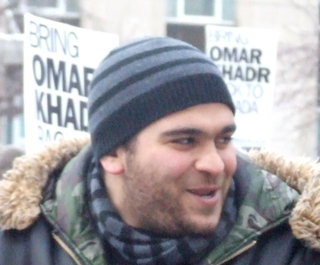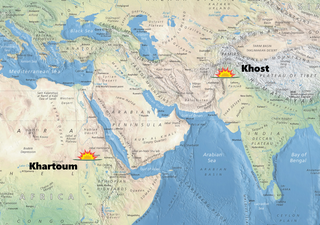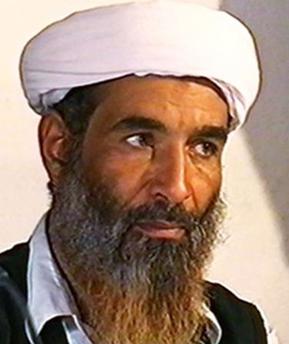
Al-Qaeda is a pan-Islamist militant organization led by Sunni Jihadists who self-identify as a vanguard spearheading a global Islamist revolution to unite the Muslim world under a supra-national Islamic state known as the Caliphate. Its membership is mostly composed of Arabs, but also includes people from other ethnic groups. Al-Qaeda has mounted attacks on civilian, economic and military targets of the US and its allies; such as the 1998 US embassy bombings, the USS Cole bombing and the September 11 attacks. The organization is designated as a terrorist group by NATO, UN Security Council, the European Union, and various countries around the world.

Osama bin Mohammed bin Awad bin Laden was a Saudi Arabian-born Islamic dissident and militant leader who was the founder and first general emir of al-Qaeda from 1988 until his death in 2011. Ideologically a pan-Islamist, he participated in the Afghan Jihad against the Soviet Union and supported the activities of the Bosnian mujahideen during the Yugoslav Wars. Bin Laden is most widely known as the mastermind of the September 11 attacks in the United States.

Ayman Mohammed Rabie al-Zawahiri was an Egyptian-born militant and physician who served as the second general emir of al-Qaeda from June 2011 until his death in July 2022.

Abdurahman Ahmed Said Khadr is a Canadian citizen who was held as an enemy combatant in extrajudicial detention in the United States Guantanamo Bay detainment camps, in Cuba, after being detained in 2002 in Afghanistan under suspicion of connections to Al-Qaeda. He later claimed to have been an informant for the CIA. The agency declined to comment on this when asked for confirmation by the United States' PBS news program Frontline. He was released in the fall of 2003 and ultimately returned to Canada.

Operation Infinite Reach was the codename for American cruise missile strikes on al-Qaeda bases that were launched concurrently across two continents on 20 August 1998. Launched by the U.S. Navy, the strikes hit the al-Shifa pharmaceutical factory in Khartoum, Sudan, and a camp in Khost Province, Afghanistan, in retaliation for al-Qaeda's August 7 bombings of American embassies in Kenya and Tanzania, which killed 224 people and injured over 4,000 others. Operation Infinite Reach was the first time the United States acknowledged a preemptive strike against a violent non-state actor.

The Maktab al-Khidamat, also Maktab Khadamāt al-Mujāhidīn al-'Arab, also known as the Afghan Services Bureau, was founded in 1984 by Abdullah Azzam, Wa'el Hamza Julaidan, Osama bin Laden and Ayman al-Zawahiri to raise funds and recruit foreign mujahideen for the war against the Soviets in Afghanistan. MAK became the forerunner to al-Qaeda and was instrumental in creating the fundraising and recruitment network that benefited Al-Qaeda during the 1990s.
Jamal Ahmed al-Fadl is a Sudanese militant and former associate of Osama bin Laden in the early 1990s. Al-Fadl was recruited for the Afghan war through the Farouq mosque in Brooklyn. In 1988, he joined Al-Qaeda and took an oath of fealty to Bin Laden. After a dispute with Bin Laden, al-Fadl defected and became an informant to the United States government on al-Qaeda's activities.
On 13 January 2006 the Central Intelligence Agency fired missiles into the Pakistani village of Damadola in the Bajaur tribal area, near the Afghan border, killing at least 18 people. United States officials later admitted that no al-Qaeda leaders perished in the strike and that only local villagers were killed. The attack purportedly targeted Ayman al-Zawahiri, second-in-command of al-Qaeda after Osama bin Laden, who was thought to be in the village.
Osama bin Laden, the founder and former leader of al-Qaeda, went into hiding following the start of the War in Afghanistan in order to avoid capture by the United States and/or its allies for his role in the September 11 attacks, and having been on the FBI Ten Most Wanted Fugitives list since 1999. After evading capture at the Battle of Tora Bora in December 2001, his whereabouts became unclear, and various rumours about his health, continued role in al-Qaeda, and location were circulated. Bin Laden also released several video and audio recordings during this time.

The Battle of Tora Bora was a military engagement that took place in the cave complex of Tora Bora, eastern Afghanistan, from November 30 – December 17, 2001, during the final stages of the United States invasion of Afghanistan. It was launched by the United States and its allies with the objective to capture or kill Osama bin Laden, the founder and leader of the militant organization al-Qaeda. Al-Qaeda and bin Laden were suspected of being responsible for the September 11 attacks three months prior. Tora Bora is located in the Spīn Ghar mountain range near the Khyber Pass. The U.S. stated that al-Qaeda had its headquarters there and that it was bin Laden's location at the time.

On May 2, 2011, Osama bin Laden, the founder and first leader of the Islamist militant group al-Qaeda, was shot and killed at his compound in the Pakistani city of Abbottabad by United States Navy SEALs of SEAL Team Six. The operation, code-named Operation Neptune Spear, was carried out in a CIA-led mission, with the Joint Special Operations Command (JSOC) coordinating the Special Mission Units involved in the raid. In addition to SEAL Team Six, participating units under JSOC included the 160th Special Operations Aviation Regiment (Airborne), also known as the "Night Stalkers," and the CIA's Special Activities Division, which heavily recruits from former JSOC Special Mission Units. The success of the operation ended a nearly decade-long manhunt for bin Laden, who was accused of masterminding the September 11 attacks on the United States.

The Bin Laden Issue Station, also known as Alec Station, was a standalone unit of the Central Intelligence Agency in operation from 1996 to 2005 dedicated to tracking Osama bin Laden and his associates, both before and after the 9/11 attacks. It was headed initially by CIA analyst Michael Scheuer and later by Richard Blee and others.

Hamza bin Osama bin Mohammed bin Awad bin Laden, better known as Hamza bin Laden, was a Saudi Arabian-born member of al-Qaeda. He was a son of al-Qaeda leader Osama bin Laden, and, following his father's death in 2011, he was described as an emerging leader of the al-Qaeda organization.

Several sources have alleged that the Central Intelligence Agency (CIA) had ties with Osama bin Laden's faction of "Afghan Arab" fighters when it armed Mujahideen groups to fight the Soviet Union during the Soviet–Afghan War.
Osama bin Laden, a militant Islamist and co-founder of al-Qaeda, in conjunction with several other Islamic militant leaders, issued two fatawa – in 1996 and then again in 1998—that military personnel from the United States and allied countries until they withdraw support for Israel and withdraw military forces from Islamic countries. He was indicted in United States federal court for his alleged involvement in the 1998 U.S. embassy bombings in Dar es Salaam, Tanzania and Nairobi, Kenya, and was on the U.S. Federal Bureau of Investigation's Ten Most Wanted Fugitives list until his death.
This is a list of activities ostensibly carried out by the U.S. Central Intelligence Agency (CIA) within Pakistan. It has been alleged by such authors as Ahmed Rashid that the CIA and ISI have been waging a clandestine war. The Afghan Taliban—with whom the United States was officially in conflict—was headquartered in Pakistan's Federally Administered Tribal Areas during the war and according to some reports is largely funded by the ISI. The Pakistani government denies this.

An Afghan jihadist camp, or an Afghan training camp, is a term used to describe a camp or facility used for militant training located in Afghanistan. At the time of the September 11 attacks in 2001, Indian intelligence officials estimated that there were over 120 jihadist camps operating in Afghanistan and Pakistan, run by a variety of militant groups.

Mohammed Atef was the prominent military chief of al-Qaeda, and a deputy of Osama bin Laden, although Atef's role in the organization was not well known by intelligence agencies for years. He was killed in a US airstrike in November 2001.

Manhunt: The Search for Bin Laden is a 2013 documentary film directed by Greg Barker that explores the Central Intelligence Agency's investigation of Osama bin Laden, starting from 1995 until his death in 2011. It premiered on HBO on May 1, 2013, two years after the mission that killed bin Laden. The documentary features narratives by many of the CIA analysts and operatives who worked over a decade to understand and track bin Laden, and includes archival film footage from across Washington, D.C., Pakistan, Saudi Arabia and elsewhere in the Middle East. It also features extensive and rarely seen footage of Al-Qaeda training and propaganda videos, including video suicide notes from various terrorists who later worked as suicide bombers.
The following is an outline of the series of events that led up the War in Afghanistan (2001–2021).













